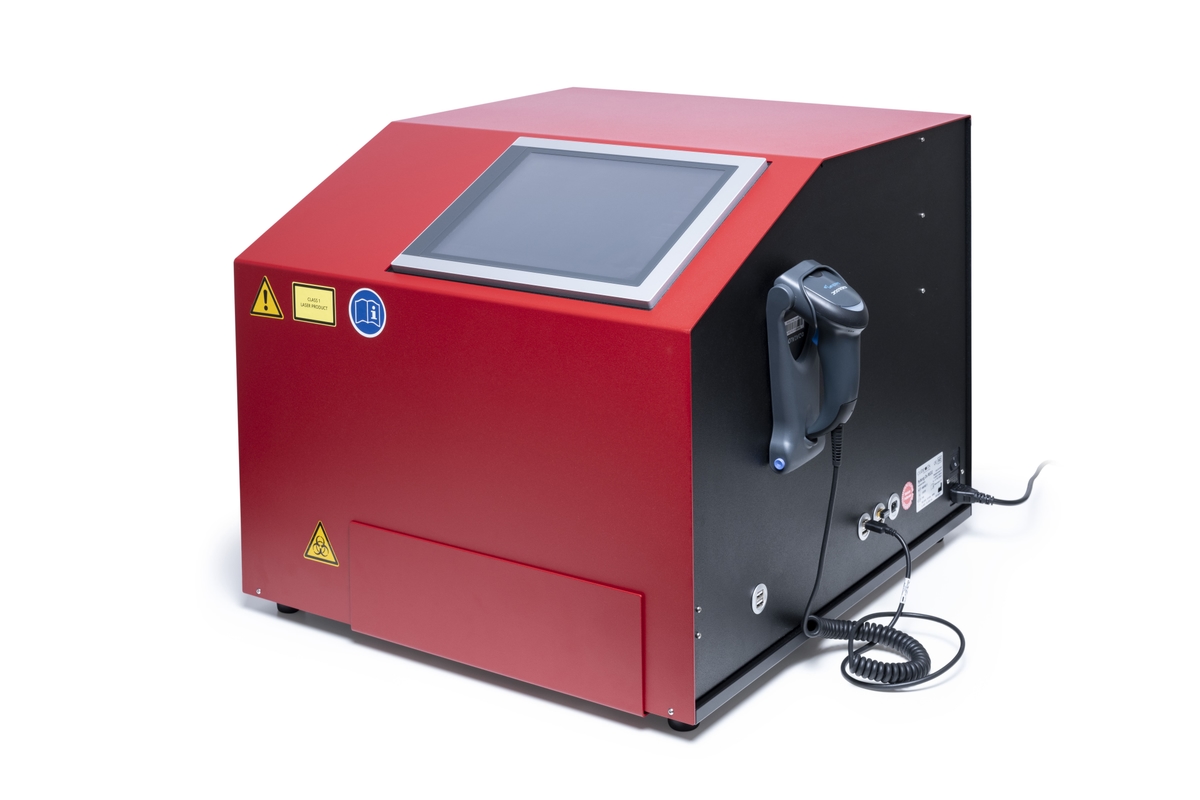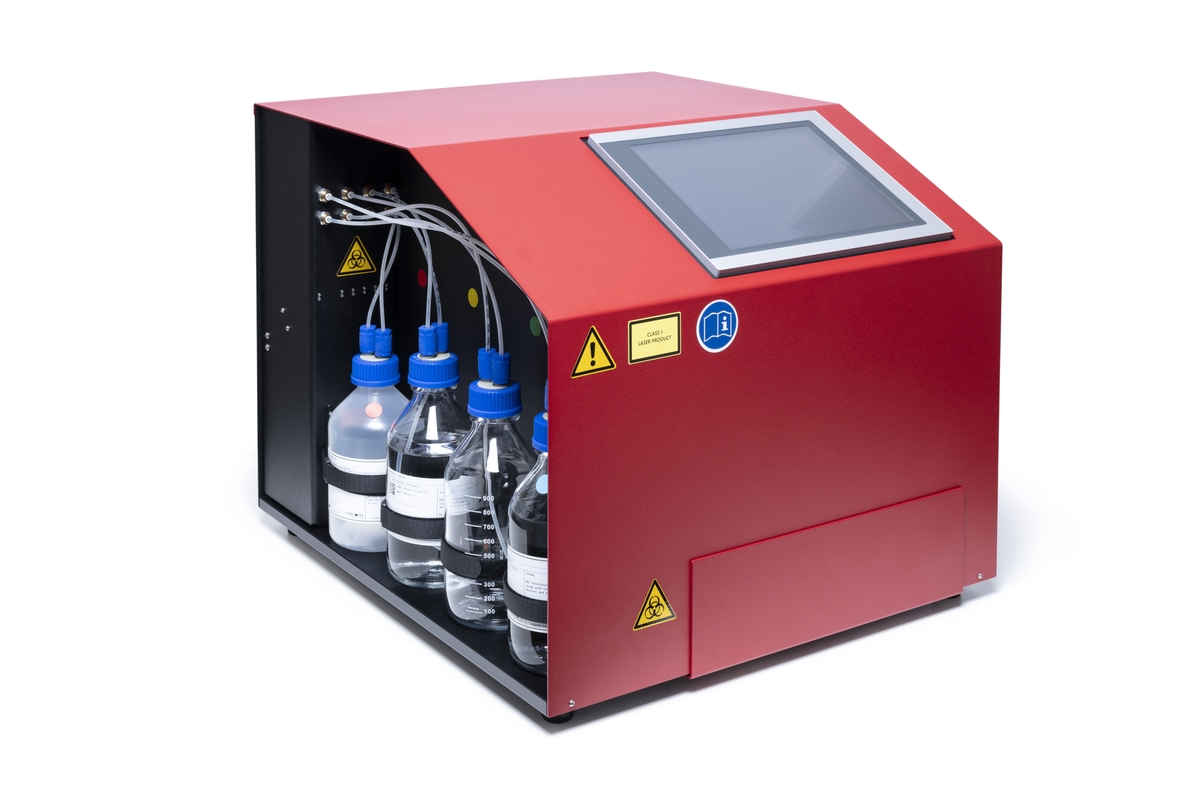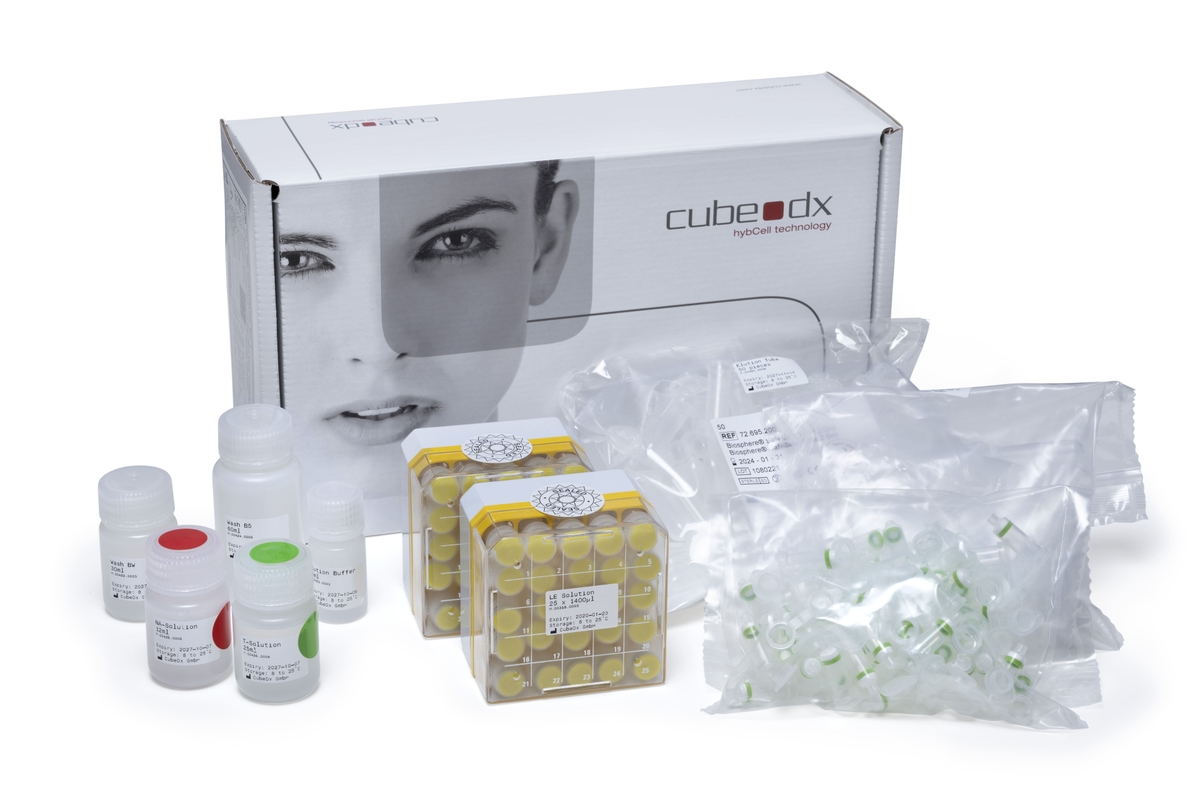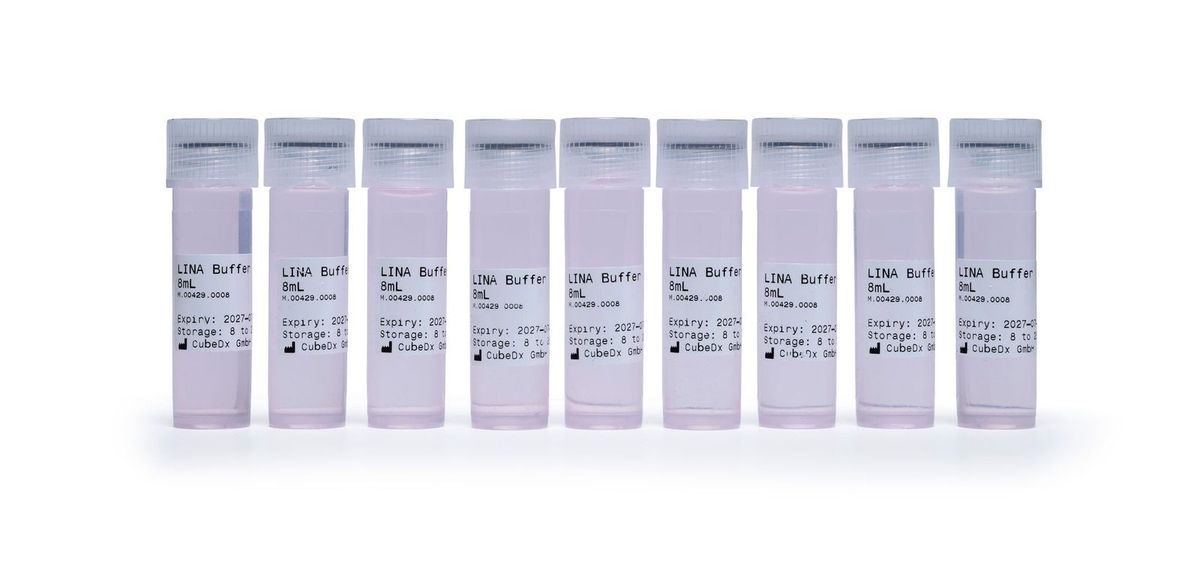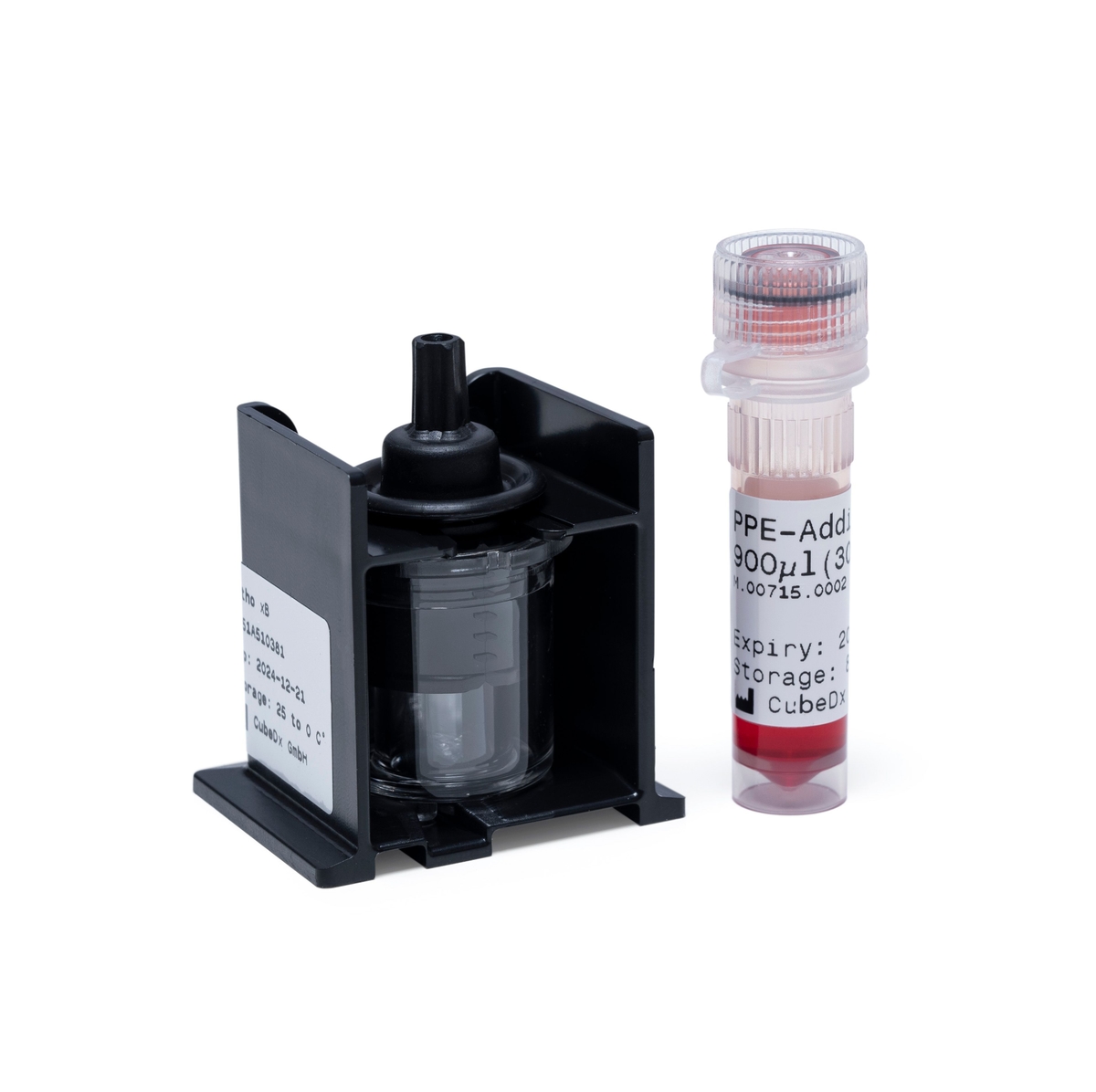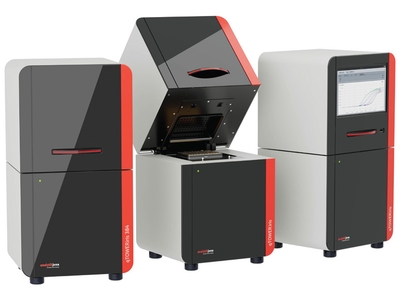
- Home/
- Products/
- Bacteriological equipment/
- Bacteriological analyser/
- Bacteriological analyser hyborg Dx RED2
- NEW
- IVD
- TOP
Bacteriological analyser hyborg Dx RED2
| Manufacturer: | Cube DX |
|---|---|
| Country: | Austria |
Specialist consultation
+38 (067) 880 44 83Details
HYBORG – AUTOMATED PROCESSING AND REPORTING
The hyborg processes hybcell assays in a fully automated format. It is tailored for operation in a (clinical) routine laboratory and guarantees limited hands-on time, ease of usage, and clear reports.
The test is based on three steps: sample preparation and DNA purification, PCR and identification with the hybcell.
The PCR screening for bacteria (16S rDNA) and fungi (28S rDNA) and the follow up identification process on the hybcell are termed compact sequencing, and the test components (PCR mixes and hybcells) and processes are the same for all intended uses. The treatment of the different sample matrices differs strongly between analysing whole blood for sepsis diagnostics or BAL / positive blood cultures for diagnosing pneumonia and other infections.
Whereas analysing whole blood requires the removal of human DNA using the GINA kit, BAL or positive blood cultures require no DNA extraction process whatsoever and use the modulation buffer LINA instead.
DIAGNOSING SEPSIS – WITHOUT CULTURING / FROM BLOOD
CubeDx supports clinicians by providing a very early indication of sepsis-causing microorganisms directly in whole blood. Testing whole blood reduces the time to result to just 3 hours! Our multiplex technology allows for identification of more than 100 targets (bacteria, fungi and resistance genes) in parallel.
TESTED PANELS
BACTERIA
|
|
|
A |
Abiotrophia defectiva |
E |
Ehrilichia |
M |
Micrococcus luteus |
|
|
|
|
Acinetobacter baumanii |
|
Eikinella corrodens |
|
Moraxella catarrhalis |
|
|
|
|
Acinetobacter calcoaceticus |
|
Enterobacter asburiae / cancerogenus |
|
Morganella morganii |
|
|
|
|
Actinobacillus pleuropneumoniae |
|
Enterobacter cloacae |
|
Mycoplasmoides pneumoniae |
|
|
|
|
Aerococcus urinae |
|
Enterobacter cloacae complex |
|
|
|
|
|
|
Aerococcus viridans |
|
Enterobacter hormaechei |
N |
Neisseria meningitidis |
|
|
|
|
Aggregatibacter actinomycetemcomitans |
|
Enterobacter kobei / ludwigii |
|
Nocardia |
|
|
|
|
Alcaligenes faecalis |
|
Enterobacter roggenkampii |
|
|
|
|
|
|
Anaerococcus |
|
Enterococcus faecalis |
P |
Pantoea |
|
|
|
|
|
|
Enterococcus faecium |
|
Pasteurella multocida |
|
|
|
B |
Bacteroides fragilis |
|
Escherichia coli |
|
Prevotella buccae |
|
|
|
|
Bartonella bacilliformis |
|
|
|
Prevotella intermedia |
|
|
|
|
Bartonella henselae |
F |
Finegoldia magna |
|
Propionabacteriaceae — Cucitibacterium acnes |
|
|
|
|
Bartonella quintana |
|
Francisella tularesis |
|
Proteus mirabilis |
|
|
|
|
Bordetella pertussis / parapertussis |
|
Fusonacterium nucleatum |
|
Providencia stuartii |
|
|
|
|
Borreliella (Borrelia) burgdorferi |
|
Fusonacterium necrophorum |
|
Pseudomonas aeruginosa |
|
|
|
|
Brucella |
|
Granulicatella adiacens |
|
Pseudomonas non-aeruginosa |
|
|
|
|
Burkholderia cepacia complex |
|
|
|
|
|
|
|
|
Burkholderia pseudomallei |
G |
Granulicatella adiacens |
R |
Rickettsia |
|
|
|
|
|
|
|
|
|
|
|
|
C |
Campylobacter |
H |
Haemophilus haemoliticus |
S |
Salmonella enterica |
|
|
|
|
Citrobacter freundii complex |
|
Haemophilus influenzae |
|
Serratia marcescens |
|
|
|
|
Citrobacter koseri |
|
Haemophilus parainfluenzae |
|
Staphylococcus aureus |
|
|
|
|
Clostridium perfringens |
|
Helicobacter pylori |
|
Stenotrophomonas maltophilia group |
|
|
|
|
Corynebacterium diphteriae |
|
|
|
Streptococcus anginosus group |
|
|
|
|
Corynebacterium jeikeium |
K |
Kingella |
|
Streptococcus agalactiae |
|
|
|
|
Corynebacterium ulcerans |
|
Klebsiella aerogenes |
|
Streptococcus dysgalactiae |
|
|
|
|
Coxiella |
|
Klebsiella oxytoca |
|
Streptococcus equinus |
|
|
|
|
|
|
Klebsiella pneumoniae |
|
Streptococcus gordonii |
|
|
|
|
|
|
Klebsiella varicola subsp. tropica |
|
Streptococcus mitis |
|
|
|
|
|
|
|
|
Streptococcus pneumoniae |
|
|
|
|
|
L |
Legionella pneumophila |
|
Streptococcus pyogenes |
|
|
|
|
|
|
Listeria |
|
Streptococcus salivarius group |
|
|
|
|
|
|
|
|
|
|
|
|
|
|
|
|
Y |
Yersinia enterocolitica |
|
|
|
|
|
|
|
|
Yersinia pseudotuberculisis complex |
RESISTANCE GENES
|
|
|
+ |
Vancomycin resistances |
– |
Betalactamase/Carbapenemase |
|
|
|
|
|
|
vanA |
|
IMP |
|
|
|
|
|
|
vanB |
|
KPC |
|
|
|
|
|
|
|
|
NDM |
|
|
|
|
|
|
Meticillin resistances |
|
VIM |
|
|
|
|
|
|
mecA |
|
OXA48 |
|
|
|
|
|
|
mecC |
|
|
|
|
FUNGI
|
|
|
A |
Aspergillus clavatus |
C |
Candida albicans |
N |
Nakaseomyces bracarensis |
|
|
|
|
Aspergillus flavus |
|
Candida dubliniensis |
|
Nakaseomyces glabratus |
|
|
|
|
Aspergillus fumigatus |
|
Candida parapsilosis |
|
Nakaseomyces nivariensis |
|
|
|
|
Aspergillus niger |
|
Candida tropicalis |
|
|
|
|
|
|
Aspergillus terreus |
|
Candida auris |
|
|
|
|
|
|
|
|
Candida duobushaemulonii |
P |
Pichia kudriavzevii |
|
|
|
|
|
|
Candida haemulonii |
|
Pneumocystis jirovecii |
|
|
|
|
|
|
Cryptococcus neoformans |
|
Pneumocystis mutina |
|
|
|
|
|
|
Cryptococcus gattii |
|
|
|
|
|
|
|
|
|
S |
Saccharomyces cerevisiae |
|
|
|
|
|
F |
Fusarium oxysporum species complex |
|
Scedosporium |
|
|
|
|
|
|
Fusarium solani species complex |
|
|
SIMPLE WORKFLOW
Fresh EDTA blood (0.5ml) serves as a sample. To validate a negative result, an Internal Process Control (IPC) can optionally be introduced into the sample.
During the GINA process, most cells of human origin are depleted before DNA is purified.
The enriched microbial DNA is amplified using a choice of PCR master-mixes: pan-bacterial PCR, pan-fungal PCR or PCR to screen for several resistance genes.
Positive samples are transferred into the hybcell cartridges, and the microorganisms and resistance genes are identified by the hybcell and its compact sequencing process, with the results subsequently presented in a comprehensive report.
FEATURES / ADVANTAGES:
• Results in just 3 hours!
• Yield of up to 98% of microbial DNA
• Limit of detection (whole blood): 20 CFU/mL
• Early and comprehensive results from 0.5 mL whole blood
• Sensitive and parallel identification of bacteria, fungi, and resistance genes
• Identification of multiple pathogens/mixed infections
• Simple handling, an optimized workflow with 24/7 availability and immediate results
Characteristics
| Technology | Compact sequencing on hybcell |
|---|---|
| Sample volume | 500 µl |
| Detection limit | 10-20 CFU/ml |
| Time from sample to report | 3 hours |
| Regulatory status | CE IVD |
| Sound pressure level during operation | < 70 dB |
| Electronic interfaces | USB 2.0, Ethernet (RJ-45) |
| Sample types | Whole blood, positive blood culture, BAL, tissue, CSF, urine |
|---|---|
| Targeted detection | Bacteria, fungi, resistance genes |
| Type of analysis | Qualitative |
| Software availability | Yes |
| Automatic cleaning | After each cycle |
| Power consumption | Max. 480 W |
Service and Warranty
We provide premium service and maintenance for every device and consumable:
• Comprehensive maintenance of medical equipment
• Installations, commissioning
• Warranty and post-warranty service
• Instruction, training and consultations for your team
More details on the SERVICE page
| Contact phone | +38 (067) 133 05 52 |
|---|---|
| E-mail: | service@empirica.healthcare |
.jpg)
